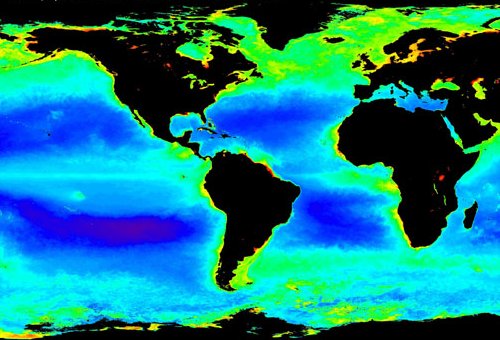Water Composition (4/5)
Plankton & Visibility
Thermal stratification has a pronounced effect on the growth of phytoplankton. Phytoplankton are single-celled algae suspended in the water column. Phytoplankton require chemical nutrients, primarily invisible phosphates and nitrates, dissolved at fairly low levels in the water, as well as oxygen. Phytoplankton also requires sufficient light for photosynthesis in order to grow. This restricts its growing zone to the upper layers of the water column, known as the photic zone. While it does not immediately die in the darker deep waters, phytoplankton cannot grow there. Phytoplankton are fed upon by zooplankton ( microscopic animals ) thus forming the first two levels in the food pyramid of the sea. Although almost all of these organisms are too small to see with the naked eye, all together they can have a great effect on water clarity, or what we divers call visibility.


In the winter, surface and deep waters are well mixed, such that sufficient nutrients are found at all levels, including the surface waters that receive enough light for phytoplankton to grow. The amount of plankton that grows in the winter is limited by the cold temperatures and the relatively poor winter illumination. As the days lengthen into spring, phytoplankton make use of the increased light and high nutrient levels, resulting in an "algae bloom." the zooplankton lag behind the phytoplankton in numbers, but eventually they catch up and the "bloom" is consumed.
With the formation of the summer thermocline, the surface waters are separated from the bottom waters, making the nutrients there unavailable to the phytoplankton, which soon exhaust what nutrients are available to them in the lighted upper waters. At this point, numbers of both phytoplankton and zooplankton drop. For us, the water clears up. This situation is maintained until the thermocline breaks down in the fall, allowing the untapped nutrients from the deep waters to mix up into the photic zone again, and generally resulting in another algae bloom, although not as great as in the spring. As with stratification, these same algae cycles also occur in many freshwater bodies as well.



While almost all phytoplankton is microscopic, not all zooplankton is so small - some jellyfishes are up to 8 feet across! Many planktonic crustaceans, worms, fish larvae, and other creatures are visible to the naked eye, if you are looking.
Marine Snow

Another factor that affects water clarity and visibility is "marine snow." Marine snow is composed of microscopic bits of non-living matter - soot, dust, sand, dead plankton, fecal particles, etc - that is held together by sticky bacterial waste products and slowly sinks down in the water column.
Marine snow is extremely fragile, and at night the swimming actions of feeding zooplankton breaks it up. However, during the day it may aggregate into visible clumps or strings, what we divers refer to as "Egg Drop Soup." Marine snow was actually discovered by scuba divers, since it is so difficult to collect by the usual means of plankton sampling because it is so fragile.
Sea Foam

When it looks as if the beach or surf is littered with billows of soapsuds, the reason is not that someone has dumped a carload of detergent into the ocean. This common sight of spring and summer ( and occasionally, brief periods in fall and winter ) results from the prolific reproduction of "phytoplankton." Each microscopic individual is housed in a skeleton made of calcium or silica. Conditions of sun, temperature, and nutrients stimulate rapid growth and reproduction. When the cycle has run its course, billions of individuals die.
Sea foam is created when waves or strong winds inject air into the dissolved organic matter in ocean water, forming bubbles. The organic matter, mostly made of dead phytoplankton, contains protein that gives the saltwater enough surface tension to form bubbles. Surf and winds cause the mass to pile up in the familiar, suds-like masses. Windrows of phytoplankton remains show that the sea off our coast is producing tons of food for other creatures in the food web.

